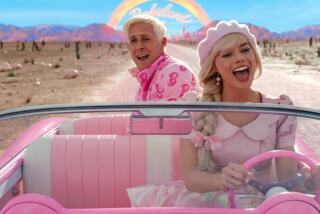PACIFIC RIM TRADE : Profiles : For Asian Tycoons, Success Is a Matter of Seizing Initiative : Whether manufacturing toys or exporting rice, these business leaders have prospered by knowing when to make their moves. : DENNIS H. S. TING, 61, <i> Hong Kong toy tycoon </i>
- Share via
When the “Star Wars” craze was raging in the United States, Dennis Ting’s companies produced R2-D2 plastic figurines--80 million of them. Cabbage Patch Dolls? Ten million of the stuffed creatures. Mighty Morphin Power Rangers--Jason, Trini, Zach, Kimberly, Billy? Ting makes jillions of them along with disgusting plastic things called Burp Balls, anti-gravity toy cars that drive on the ceiling and Susie Scribbles, a near life-size doll who sits at a desk and “can write anything she says.”
The showroom in his Kowloon headquarters is a child’s delight and a parent’s nightmare of large and small plastic toys.
Ting, cherubic and constantly grinning during an interview in his spacious office decorated with equally cherubic Buddhist sculpture, is one of the Hong Kong toy tycoons. His products, manufactured just across the border in China, are a $9-billion-a-year business and dominate the world’s toy market.
According to the Toy Manufacturers of America, more than 60% of all toys, dolls, games and Christmas decorations are made in China and enter the U.S. market via the Hong Kong connection.
Ting, chairman of the board of Kader Holdings Co. Ltd. and managing director of Qualidux Industrial Co. Ltd., two of Hong Kong’s largest toy manufacturers, entered the business in the early 1950s after emigrating to Hong Kong with his family from his native Shanghai.
In Shanghai, the family had manufactured dry-cell batteries and brass flashlights. But after seeing the waterproof plastic flashlights carried by American GI’s who arrived in Shanghai after World War II, the family envisioned a future made of plastic.
In Hong Kong, their first foray into plastic production met with failure after molds they ordered from the United States, for the manufacture of chopsticks and hair combs, did not work.
But Ting, educated in the United States at Colby College in Maine, said the setback was a blessing because it forced the family into the business of making its own molds.
Soon they were producing the chassis for toy plastic cars and the plastic fixtures for Lionel trains. Gradually, Hong Kong replaced Japan as the world’s leading manufacturing center for toys.
In 1980, facing an increasingly expensive Hong Kong labor market, Ting and all of the other Hong Kong toy makers began moving their manufacturing operations across the border to China, in the “special economic zone” created in Shenzhen by the Chinese government.
Ting’s two companies have 15,000 employees in China. Overall, Hong Kong toy makers with plants in China employ an estimated 300,000 workers.
Often conditions in factories that make American children’s playthings are not pleasant or safe. In Thailand, for instance, Ting’s Kader Holdings was half-owner of a Bangkok toy factory that collapsed and burned last year, killing 240 workers.
But Ting said his companies’ Chinese factories are all made of concrete to prevent such a tragedy.
“We have regular fire drills, three firefighters on staff,” he said.
More to Read
Inside the business of entertainment
The Wide Shot brings you news, analysis and insights on everything from streaming wars to production — and what it all means for the future.
You may occasionally receive promotional content from the Los Angeles Times.










